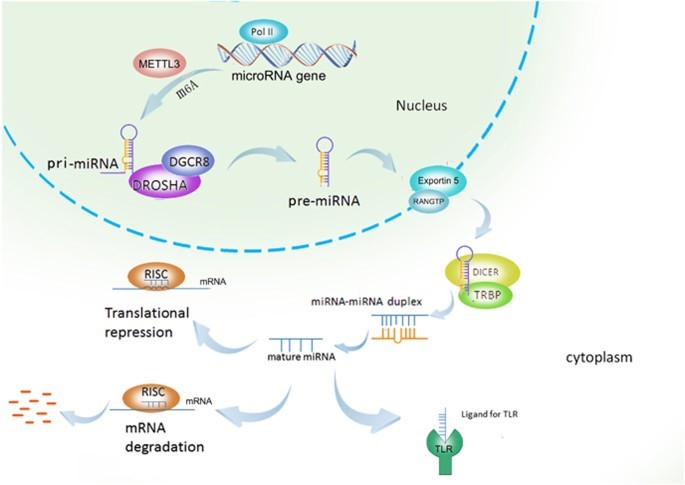Description

Disclaimer: Copyright infringement not intended.
Context
- The team at the University of Massachusetts-Amherst in the US found that the microRNA, called let-7, also has the ability to recognise and remember tumour cells like T-cells.
Details
- Recognition and Memory: The researchers at the University of Massachusetts-Amherst identified let-7 as a microRNA that can recognize and remember tumor cells, similar to the way our immune system's T-cells work. This cellular memory is a fundamental aspect of how vaccines function.
- Immune System and T-Cells: T-cells are white blood cells that specialize in fighting pathogens and abnormal cells, including tumor cells. When T-cells encounter foreign antigens in the body, they transform into killer T-cells and mount an attack. However, most killer T-cells die after the battle.
- Formation of Memory Cells: After a successful encounter, a few T-cells survive and become memory cells. These memory cells retain the ability to recognize specific antigens they have encountered in the past. This memory pool allows the immune system to respond more effectively if the same antigen reappears in the future.
- Cancer Immune Evasion: Cancerous tumor cells often evade the immune system by preventing T-cells from forming memory cells. They trick the immune system into not recognizing them as threats, allowing the cancer to spread unchecked.
- Role of let-7: The study discovered that let-7, a tiny piece of microRNA that has been conserved throughout evolutionary history, is highly expressed in memory cells. Cells with more let-7 are less likely to be deceived by cancer cells, increasing the chances of these cells becoming memory cells.
- Longevity of Memory Cells: Memory cells have a long lifespan and can possess stem-cell-like features. They can persist in the body for decades, up to 70 years, allowing the immune system to remember and respond to specific threats over extended periods.
- Implications for Cancer Treatment: Understanding how let-7 is regulated during treatment could enhance the memory and capabilities of the immune system. This knowledge may lead to the development of novel immunotherapies that can boost the immune system's ability to recognize and target cancer cells effectively.

About MicroRNA (miRNA)
- MicroRNAs (miRNAs) are a class of small, non-coding RNA molecules that play critical regulatory roles in various biological processes.
- These molecules, typically 18 to 22 nucleotides in length, were discovered in the early 1990s and have since emerged as key players in gene expression regulation.
Discovery of MicroRNAs
- MiRNAs were first discovered in Caenorhabditis elegans, a nematode worm, by Victor Ambros and Gary Ruvkun in 1993. They identified a small RNA molecule called lin-4 that regulated the timing of larval development.
- This discovery led to the realization that small RNA molecules like miRNAs could have widespread regulatory roles in gene expression.
Biogenesis of miRNAs
- MiRNAs are transcribed from DNA into long primary transcripts (pri-miRNAs) by RNA polymerase II.
- These pri-miRNAs are processed in the nucleus by the Drosha-DGCR8 complex into shorter hairpin structures called precursor miRNAs (pre-miRNAs).
- Pre-miRNAs are then transported to the cytoplasm and further processed by Dicer into mature miRNAs.
- Mature miRNAs are loaded into the RNA-induced silencing complex (RISC), where they guide the complex to target messenger RNAs (mRNAs).
Functions of MiRNAs
- MiRNAs regulate gene expression post-transcriptionally by binding to the 3' untranslated region (UTR) of target mRNAs, leading to mRNA degradation or translational repression.
- They play vital roles in numerous biological processes, including development, differentiation, cell cycle regulation, apoptosis, and immune responses.
- Dysregulation of miRNAs is implicated in various diseases, including cancer, neurodegenerative disorders, cardiovascular diseases, and metabolic disorders.
Roles in Cancer
- Aberrant miRNA expression is a hallmark of many cancers. MiRNAs can act as oncogenes by suppressing tumor suppressor genes or as tumor suppressors by inhibiting oncogenes.
- MiRNAs are potential diagnostic and prognostic markers in cancer and are being explored for therapeutic interventions.
Therapeutic Potential
- MiRNAs are promising targets for drug development, with ongoing research into miRNA-based therapies.
- miRNA mimics and antimiRs (antisense oligonucleotides) are being developed to either restore or inhibit specific miRNAs, respectively, in disease contexts.
Technological Advances
- Advances in high-throughput sequencing and bioinformatics have facilitated the discovery and profiling of miRNAs.
- Researchers use techniques like miRNA microarrays, RNA sequencing, and quantitative PCR to study miRNA expression patterns.
Future Directions
- MiRNAs continue to be an active area of research with ongoing efforts to unravel their roles in various biological processes and diseases.
- Understanding miRNA biology holds the promise of uncovering new therapeutic targets and diagnostic markers.
.jpg)
Conclusion
microRNAs are a fascinating class of molecules with crucial regulatory functions in gene expression. They have profound implications in biology, disease, and potential therapeutic interventions. Research in this field is dynamic and continually expanding, offering exciting prospects for the future of medicine and biology.
|
PRACTICE QUESTION
Q. Discuss the significance of microRNA in the context of cancer immunity and memory formation within the immune system. How can understanding the role of miRNA contribute to the development of novel strategies for cancer immunotherapy? (250 Words)
|











